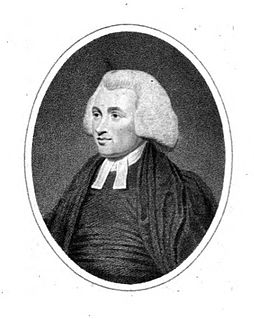
Homerton College is a constituent college of the University of Cambridge. Its first premises were acquired in Homerton, London in 1768, by an informal gathering of Protestant dissenters with origins in the seventeenth century. In 1894, the college moved from Homerton High Street, Hackney, London, to Cambridge. Homerton was admitted as an "Approved Society" of the university in 1976, and received its Royal charter in 2010, affirming its status as a full college of the university. The college celebrated its 250th anniversary in 2018.
Trefeca, located between Talgarth and Llangorse Lake in what is now south Powys in Wales, was the birthplace and home of the 18th-century Methodist leader Howell Harris. It was also the site of two Calvinistic Methodist colleges at different times; the first sponsored by Selina, Countess of Huntingdon in the late eighteenth century; the second supported by the Welsh Calvinistic Methodist Connexion in the later nineteenth century.

Abney Park cemetery is one of the "Magnificent Seven" cemeteries in London, England.

Christopher Newman Hall, born at Maidstone and known in later life as a 'Dissenter's Bishop', was one of the most celebrated nineteenth century English Nonconformist divines. He was active in social causes; supporting Abraham Lincoln and abolition of slavery during the American Civil War, the Chartist cause, and arranging for influential Nonconformists to meet Gladstone. His tract Come to Jesus, first published in 1848 also contributed to his becoming a household name throughout Britain, the US and further afield, supposedly selling four million copies worldwide over his lifetime.

Covenant Theological Seminary, sometimes known as Covenant Seminary, is the denominational seminary of the Presbyterian Church in America (PCA) and it is located in Creve Coeur, Missouri. Covenant trains leaders for work in the church and the world — especially as pastors, missionaries, and counselors. It does not require all students to be members of the PCA, but it is bound to promote the teachings of its denomination. Faculty must subscribe to the system of biblical doctrine outlined in the Westminster Standards.

The London Missionary Society was an interdenominational evangelical missionary society formed in England in 1795 at the instigation of Welsh Congregationalist minister Edward Williams. It was largely Reformed in outlook, with Congregational missions in Oceania, Africa, and the Americas, although there were also Presbyterians, Methodists, Baptists, and various other Protestants involved. It now forms part of the Council for World Mission.

George Collison (1772–1847) was an English Congregationalist and educator associated with Hackney Academy or Hackney College, which became part of New College London—itself part of the University of London.

New College London (1850–1980) was founded as a Congregationalist college in 1850.

John Pye-Smith was a Congregational minister, theologian and tutor, associated with reconciling geological sciences with the Bible, repealing the Corn Laws and abolishing slavery. He was the author of many learned works.

Josiah Conder, correspondent of Robert Southey and well-connected to Romantic authors of his day, was editor of the British literary magazine The Eclectic Review, the Nonconformist and abolitionist newspaper The Patriot, the author of romantic verses, poetry, and many popular hymns that survive to this day. His most ambitious non-fiction work was the thirty-volume worldwide geographical tome The Modern Traveller; and his best-selling compilation book The Congregational Hymn Book. Conder was a prominent London Congregationalist, an abolitionist, and took an active part in seeking to repeal British anti-Jewish laws.

John Harris, English Congregational minister, Christian essayist and author, became the first Principal of New College, St John’s Wood, London.
London Seminary is an evangelical vocational training college located in Finchley, London, England.

The New College at Hackney was a dissenting academy set up in Hackney in April 1786 by the social and political reformer Richard Price and others; Hackney at that time was a village on the outskirts of London, by Unitarians. It was in existence from 1786 to 1796. The writer William Hazlitt was among its pupils, sent aged 15 to prepare for the Unitarian ministry, and some of the best-known Dissenting intellectuals spent time on its staff.
William Coward (1648–1738) was a London merchant in the Jamaica trade, remembered for his support of Dissenters, particularly his educational philanthropy.
Independent College, later Homerton Academy, was a dissenting academy in Homerton just outside London, England, in the 18th and early 19th centuries.

John Eyre was an English evangelical clergyman. He helped in establishing some of the major national evangelical institutions.
The Gravel Pit Chapel was established in 1715–16 in Hackney, then just outside London, for a Nonconformist congregation, which by the early 19th century began to identify itself as Unitarian. In 1809 the congregation moved to the New Gravel Pit Chapel nearby, while its old premises were taken over by Congregationalists. The New Gravel Pit Chapel was closed and demolished in 1969.
Thomas Williams (1724/1725–1770) was a British Congregational minister.
Homerton Baptist Church is an independent evangelical fellowship affiliated with the Association of Grace Baptist Churches.
New City College (NCC) is a large college of further education with campuses in East London and Essex. The college was formed in 2016 with the amalgamation of separate colleges, beginning with the merger between Tower Hamlets College and Hackney Community College, followed by the gradual additions of Redbridge College, Epping Forest College, and both Havering College of Further and Higher Education and Havering Sixth Form College. It is the second largest provider of post-16 education in the country since 2019.











